ATTENTION
Due to Whitsun we are closed on Monday 20th May
CE Category on a motor yacht. What does that stand for again?
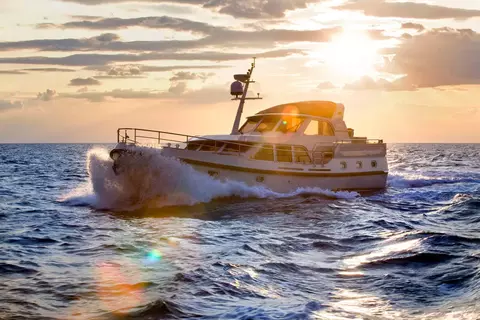
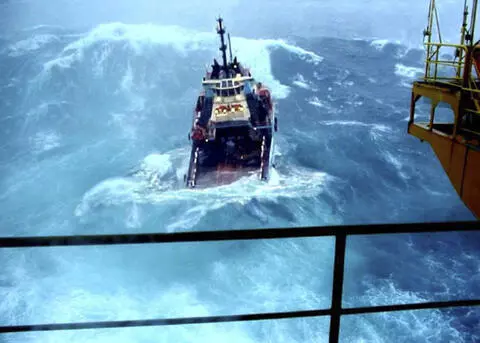
CE Certification on recreational pleasure craft motor yachts
About a genuine and false sense of safety...
The Recreational Craft Directive applies to all recreational vessels with a hull length of between 2.5 and 24 metres sold in the European Union. In this article, we will confine ourselves to a discussion of new, ready-made boats.
To understand what the Directive means and why it was enacted, we will consider a few paragraphs taken from the body of the text.
“Whereas the laws, regulations and administrative provisions in force in the various Member States relating to the safety characteristics of recreational craft differ in scope and content; whereas such disparities are liable to create barriers to trade and unequal conditions of competition within the internal market;”
We see, then, that one of the reasons for the Directive was to resolve the discrepancies between the laws of the different Member States with respect to the safety of recreational craft. Such discrepancies are a barrier to the creation of a European Area in which goods can be traded freely. Creating this “European Market” was, ultimately, the main reason that Directives such as this one were enacted.
“…whereas paragraph 3 of Article 100a provides that, in its proposals, concerning health, safety, environmental protection and consumer protection, the Commission will take as a base a high level of protection; whereas the essential requirements constitute the criteria with which recreational craft…must comply;”
The environment and the consumer must be protected (“high level of protection”), and recreational craft must therefore comply with a number of essential requirements. We will look more closely at these essential requirements in the following paragraphs.
CE marking
Before a boat can bear the CE marking, three things have to be arranged:
- The manufacturer (i.e. the boatyard) must compile a technical construction file (TCF) documenting how the boat complies with the essential requirements;
- The boat must be built in such a way that it complies with the essential requirements, which apply, amongst others to:
- The design of the boat with respect to the potential discharge of substances into the environment;
- The systems on board the boat and their safety;
- The construction of the boat;
- The stability of the boat (and possibly its buoyancy);
- The layout of the boat;
- And an owner’s manual must be provided when the owner takes delivery.
Many of the essential requirements, including that concerning the owner’s manual, are subject to ISO standards, which have been set out in the greatest of detail.This article will confine itself to the stability requirements.
One of the things that must be established before a boat is awarded the CE marking is the category in which it is to be placed. In the following, we will look at the various design categories.
As the photographs (page 27) illustrating the various design categories show, there is a major difference between Category D and Category C. It is the difference between pleasant weather with waves breaking up nicely against the bow and a heavy storm. Category B weather is weather that everyone wants to avoid, and Category A weather is a question of hanging on and surviving.
One common description of Beaufort 4 wind force (Category D, “sheltered waters”) is: “small waves, becoming larger. Fairly frequent white horses”.
Compare that to Beaufort 6 (Category C – “inshore”): “large waves begin to form; the white foam crests are more extensive everywhere. Probably some spray”. Category D weather is what every sailor desires, but no one will like being on the water when the weather turns from D to Category C, not to mention what it must be like to be offshore in typical Category B weather!
To determine a boat’s category, its stability must be calculated. There is a separate ISO standard for this calculation.
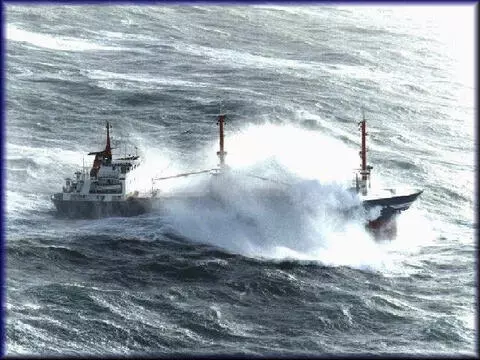
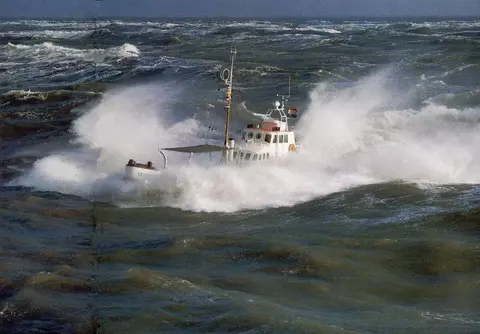
Stability, what’s that all about again?
The stability of all boats, whether or not motorised, is judged against ISO standard 12217, which has as its most important criteria:
- The downflooding height: this is the height measured from the waterline to the point at which water can first enter the interior. The downflooding height could be an engine room ventilation opening on the side of the boat, or the edge of a boat with an open cockpit. However, a porthole that can simply be closed does not count;
- The downflooding angle: this is the angle of heel that the boat must reach before water will enter the boat at the point identified by measuring the downflooding height;
- The stability range. To understand stability range, we need to consider some theoretical points.
Stability range
This is the extent to which a boat can resist incoming transverse waves and wind, calculated by comparing quantities of energy.
We base our calculation of the stability range on the RM curve. The RM curve is a graph that compares:
- The angle of heel of the boat (horizontal axis);
- And the RM or Righting Moment (on the vertical axis). But what is the Righting Moment? To put it simply: a measure for the force needed for the boat to remain upright and afloat. (See also the box “Righting Moment – Heeling Moment”).
For a better understanding of the graph, we will tell you how to “read” the various points indicated.
RM stands for the Righting Moment; in this explanation it is not described as a unit of measure such as “metres” or “kilograms”.
The design categories
A manufacturer may decide which wind force and wave heights its boat is capable of handling.
The Pleasure Craft Act says in this respect:
“Vessels in all categories must be so designed and constructed that they comply with the requirements set for such parameters as stability, buoyancy, and the other essential safety requirements referred to in this annex, and that they are easily navigable.”
The following design categories are then described; these have been taken verbatim from the Directive, and the illustrations provide a good picture of reality:
Category A – “ocean”:
“Designed for extended voyages where conditions may exceed wind force 8 (Beaufort scale) and significant wave heights of 4 metres and above, and vessels largely self-sufficient.”
Category B – “offshore”:
“Designed for offshore voyages where conditions up to, and including, wind force 8 and significant wave heights up to, and including, 4 metres may be experienced.”
Category C – “inshore”:
“Designed for voyages in coastal waters, large bays, estuaries, lakes and rivers where conditions up to, and including, wind force 6 and significant wave heights up to, and including, 2 metres may be experienced.”
Yes, that is in fact category C! The rescue boat adds some excitement to the image, but it is precisely in shallow waters that waves can reach up to 2 metres in height at wind force 6. Not all waves, of course, but the average of the highest waves: that is, ultimately, considered the “significant” wave height.
Category D – “sheltered waters”:
“Designed for voyages in sheltered waters, including along the coast, in small bays, on small lakes, rivers, and canals where conditions up to, and including, wind force 4 and significant wave heights up to, and including, 0.3 m may be experienced, occasionally rising, for example owing to passing vessels, up to, and including, 0.5 m (note: the average wave height is approximately equal to 0.7 x the significant wave height).”

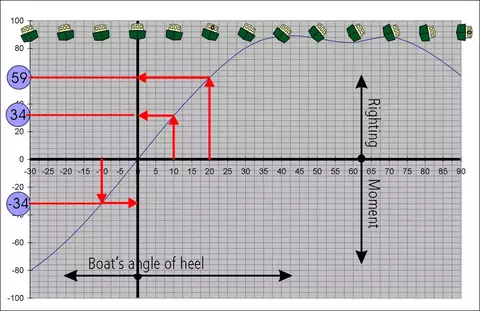
- If the boat considered in this graph has a 10-degree angle of heel, it will have an RM of 34;
- If the boat considered in this graph has a 20-degree angle of heel, it will have an RM of 59, and so forth;
- This is the same as point 1, the difference being that the boat heels to the other side, for example to port rather than to starboard. That means that there is a minus sign in front of both the angle of heel and the RM in the RM curve, to indicate that they work “in reverse”. The boat wants to right itself both at point 1 and at point 3, but in the first instance it rotates clockwise and in the second counter-clockwise.
To assess the range of stability, we not only consider the RM but also the energy “output” (see the box on “force versus work”). In the RM curve, the quantity of energy is represented by the area beneath the curve itself.
ISO 12217 determines the extent to which a boat can resist incoming transverse waves and wind:
- The quantity of energy required to give the boat a particular angle of heel when sailing into the wind (the wind also on the beam);
- The quantity of energy required to have the boat heel to the downflooding angle when sailing with the wind. If the downflooding angle is very large, a different, more realistic value is used.
The graph on the right shows the two quantities of energy.
For a better understanding of the graph:
- The horizontal line “wind moment” is the wind moment of that particular boat. This line is drawn through the new zero point: a strong side wind makes the boat pitch a few degrees. The precise angle can be determined by looking at the point at which the “wind moment” line and the RM curve cross paths. This point is designated as the “new zero point” in the graph;
- The “assumed angle of roll” is calculated according to formulas given in the ISO standard; it indicates how many degrees a boat heels into the wind in order to determine energy quantity I;
- Energy quantity II is limited by the downflooding angle or by a given maximum value.
The ISO standard states that area II must be larger than area I, or in plain nautical terminology: if transverse wind and waves hit a boat and a rogue wave is produced, causing it to heel violently into the wind, when it rolls back with the wind, it must not heel over so sharply that the boat downfloods or loses its stability.
But what are those “energies” doing with my boat?, you may ask. The comic strip below shows you what it’s really all about, this time using a real boat.
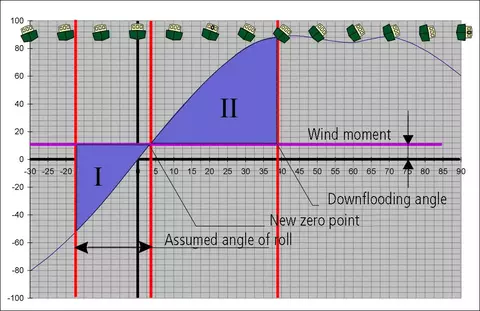

And if we translate that into the areas shown in the RM curve, we see that they represent the following in our comic strip:
- Between the first and second image: calls for a certain quantity of energy I;
- And between the second and the final image: calls for a certain quantity of energy II.
RM curve, downflooding angle, in short, the ISO standard is full of formulas. And for as much as we’re talking about real boats in real water, they are, when all is said and done, fairly abstract formulas and angles of heel that only assign a theoretical value to the stability of a boat. Now that we know which design category a boat can be assigned to, at least in principle, we will look at the way things actually are out in the field.

To which category should a boat be assigned?
There are two parties who can answer that question:
- First of all, the buyer, who all too often wants his boat in the “highest” category possible;
- And second, the boatyard, which wants the same: the “highest” possible category.
So what’s the problem, then? Just assign the boat to the highest possible category…
But it’s not as simple as that. The only correct answer to this question is “to the category in which it truly belongs”. We’ll explain below why that answer covers everything.
The buyer of boat says: “Well if I have to choose, then I want a boat in Category A” – something often heard out of the mouths of those looking to buy. Why? “It means the boat is better than one in a lower category”, or “It means the boat is safer.”
And the boatyard says: “If the stability assessment puts the boat in Category A, then why don’t we just label the boat that way?; “It makes a great sales argument”, or “Customers want that, otherwise they’ll go to some other boatyard.”
But as we said earlier: it’s not as simple as that.
We’ll illustrate our point by considering a number of assertions below.
- Putting the boat in a higher category gives the buyer a false feeling of safety. Admittedly, the boat can list pretty far before water starts to enter it. But consider just how far that actually is by inspecting the drawings below:
“only at an angle of heel of about 40-45 degrees will the gangway be immersed.”

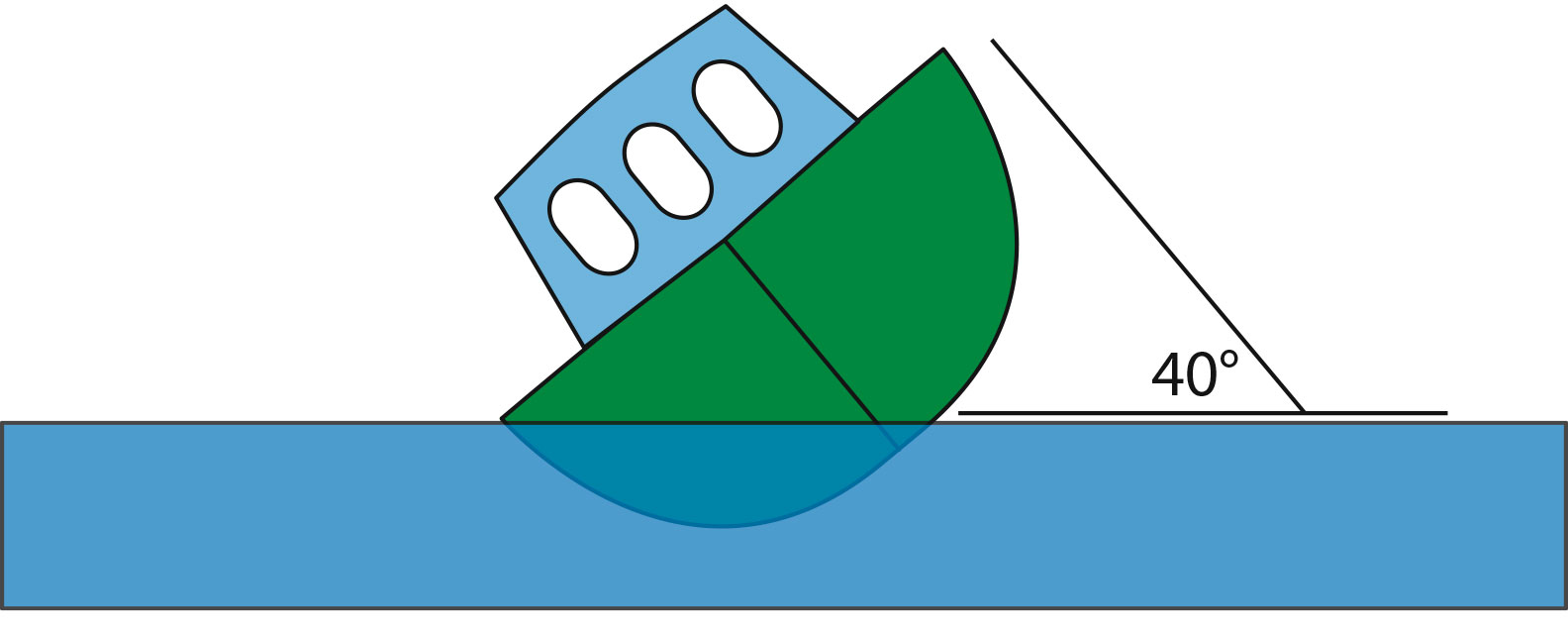
Of course, this is just a drawing, but it really is no more than a 40-degree angle. Even if your boat is capable of it, there’s nothing here that is going to make you feel safe. The boat will survive, but that doesn’t mean that it belongs in that category. Let’s look once again at what the Recreational Craft Directive says: The boat is “designed for....” It doesn’t say “will survive in….”
- By assigning the boat to too high a category, the boatyard is accepting too much responsibility. The boatyard delivers the boat and is therefore liable to some degree under the law (product liability). If we take Category A, for example, then what the boatyard is actually telling the customer is: “Go ahead and cruise offshore even in a heavy storm with the waves crashing on the quay, because this boat is designed for offshore voyages where conditions in excess of wind force 8 and wave heights in excess of 4 metres may be experienced.”
And what about Linssen Yachts?
Linssen Yachts does not take safety lightly. The health and safety officers often point to working conditions at the Linssen production facility as an example of good practice. It’s not that Linssen Yachts is eager to be held up as a model, but because it truly believes in “safety first”. It’s second nature at the firm, part of its corporate culture. That’s how Linssens are built and not in any other way. So it isn’t surprising that Linssen Yachts is very careful when assigning its boats to a design category. All the pros and cons are weighed up in a culture that puts safety and honesty first. No Linssen is ever assigned to a category beyond its capacity, simply because the boatyard loathes the idea of lying to its customers. You’ll never hear anyone in Maasbracht assuring customers that they can “head out in a heavy storm without a care.” No Linssen is ever assigned to a category beyond its capacity because the boatyard doesn’t consider it honest to do so. Your Linssen may be able to handle it – but will you? No Linssen is ever assigned to a category beyond its capacity because the boatyard feels it simply wouldn’t be right. Your Linssen should give you an honest feeling of safety, not a false one.
